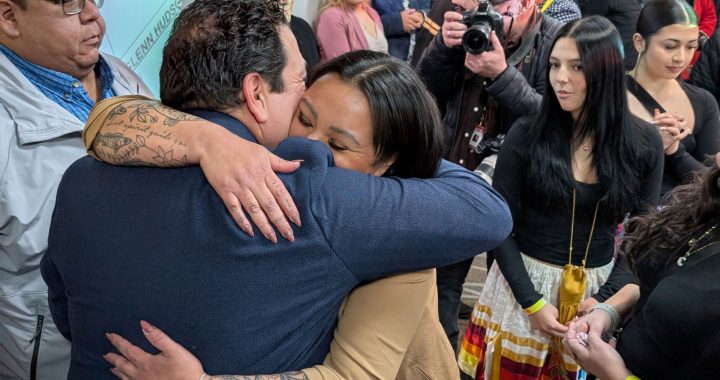A large crowd gathered in Yellowknife to witness the unveiling of a new monument honouring those lives lost and the lives that continue to be lost.
The ceremony took place outside the legislative assembly of the Northwest Territories as part of the National Day of Action for Missing and Murdered Indigenous Women and Girls and 2SLGBTQQIA+ individuals.
Inuvialuit artist Myrna (Agnaviak) Pokiak began working on the piece in May, with assistance in manufacturing the metal pieces from Paul Bros Nextreme Inc.
Pokiak said she put a lot of emotion into the design.
“A lot of family’s and friends of people who I know who have lost loved ones were with me throughout the whole journey of the design,” Pokiak said. “They are so young, so beautiful, and so talented and are just gone too soon by someone else’s evil.”
A Quilliq was lit by Inuk Elder Rassi Nashalik along with performances from Métis and Dene musicians.
Speaker of the ceremony, Frederick Blake Jr., addressed the crowd and referred to the area as a sacred place for families to visit.
“Today is a day to honour our fallen sisters, to reflect on the injustices experienced by Indigenous women, girls and two-spirited people, and to share in our healing journeys together,” Blake Jr. said.
She received feedback on the design and location from the Native Women’s Association and regional governments.
The monument is impossible to miss, directly in front of the legislative assembly, nestled between trees.
Pokiak said she was pleased with the location selected, given the high foot traffic in the area.
“It’s a big message to have it at this location, and we had a vision in place to make sure there was a fire pit and benches,” Pokiak said. “I think it is very important for families and friends who need a space for grieving that we have a space like this.”
It’s been four years since the National Inquiry into Missing and Murdered Indigenous Women and Girls released its 231 calls for justice.
Gerri Sharpe, president of Pauktuutit Inuit Women of Canada, said little has changed in the ongoing crisis, but that policymakers need to take responsibility.
“We all have a role to play, this is not an Inuit thing, this is not a dene thing, this is not a First Nations thing, this is not a Métis thing, this is a Canada issue,” Sharpe said.
In her speech, she recognized the difficulties faced by people from the northern regions when they have to travel to the south in order to access schools and medical care. She mentioned that Indigenous organizations, like Pauktuutit, have suggested providing assistance for programs like traditional midwifery, which would allow families to stay in the north.

The large statue features a red parka with a traditional sunburst hood, adorned with hearts and a Delta braid trim. Northern culture is woven into the feather infinity symbol for Métis, while a dene drum and Inuit Quilliq serve as the foundation of the monument.
Grace Blake, president of the Native Women’s Association of the NWT and Elder from the Mackenzie Delta region delivered a prayer for those with information about missing and murdered to come forward.
She also mentioned Frank Gruben, an Inuvialuit and Gwich’in man who disappeared while attending school in Fort Smith, Northwest Territories.
“This young boy that we lost in May, here in the north, no word where he is today, nothing. How sad that is for the family, for the community, they want answers and there are no answers,” Blake said. “Each member of our society, our close-knit, bonded society in the North, is valued, regardless of who they are.”
Pokaiak, who knew Frank, said she hopes monuments like this will serve as a reminder to the government of the changes that are still needed when families report their missing loved ones.
“With the current situation and the current struggles right now to find people who are missing, it’s even more important to have outside the building that can help make policy changes, to make it easier on families when they are having to search for missing loved ones.”










